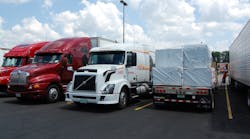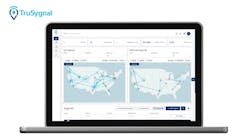A growing movement to bring so-called “advanced manufacturing” back to the U.S. – a strategic effort dubbed “reshoring” or sometimes "nearshoring" – could significantly ramp up truck capacity demand as well, according to two experts.
“One of my favorite topics is the reshoring of manufacturing back to the U.S. as there are many transportation and logistics effects associated with that,” noted John Larkin, managing director and head of transportation capital markets research at Stifel Capital Markets, during a conference call with reporters last week.
The logistics system may “touch” freight once or twice if it is delivered via containers to West Coast ports, he explained, but if the goods are produced in the U.S., that results in eight to 12 freight touches. “Thus reshoring presents a multiplier effect on freight moving around the U.S.,” Larkin said.
Rosemary Coates, executive director of the Reshoring Institute, noted during the call that “reshoring” as a strategy began to pick up steam in 2012 following an 11-year period of strong “offshoring” of manufacturing from the U.S. predominantly to China.
Between 2000 and 2011, Coates said some 2.7 million U.S. jobs were lost to offshoring, making China a huge global manufacturing “hub” in the process, with 35% to 40% of the world’s manufacturing now touching that nation or physically based there.
By Coates’ estimation, reshoring can bring some 750,000 jobs back to the U.S. largely in the “advanced manufacturing” sector, where the production of more “high dollar” finished goods such as small motors, molded plastics, and high-end textiles.
One reason she believes reshoring is “more than a fad” or the latest business “catch phrase” comes from an array of factors:
- More than half of American companies over $1 billion in revenues say they are reshoring now or considering it.
- Walmart has made a significant impact by pledging $250 billion over 10 years to buy goods made in America.
- Surveys indicate that consumers are willing to pay 10% to 12% more for products made in America.
- State, local and federal governments are supporting efforts to bring manufacturing back to the U.S. via tax and investment incentives, such as the 2014 Revitalize American Manufacturing Act, which established research and development facilities for advanced manufacturing.
Though such “advanced manufacturing” will require more robotics, 3D printer, and higher skilled – and thus more expensive – labor, shorter and more secure supply chains will help reduce the “structured cost” of such goods over time, she said.
“When the cost of a ‘reshored’ manufacturing operation is between 15% to 20% higher than what’s been off-shored to lower cost labor markets, that difference is usually enough to tip the balance” in favor of reshoring, Coates (at right) pointed out.
Where does trucking benefit in all of this? Reshored manufacturing basically aims to bring production as close to the consumer as possible, meaning more regionalized – even localized – distribution patterns for goods, she indicated; a trend that could potentially help motor carriers develop more “balanced” lanes that get drivers home more frequently.
“You’d see the transportation network shrink and be less vulnerable major disruptions such as the weather or port work stoppages,” she explained.
“And think about supply chain risks: strikes, natural disasters, geopolitical issues, and oil price fluctuations causing fluctuations in logistics costs,” she pointed out. “However, crumbling [transportation] infrastructure could be a problem, so that has to be addressed.”
Still, Coates thinks that is a management problem as reshoring is returning manufacturing to the U.S. “like raindrops” as opposed to the “Tsunami-like” offshoring induced.
Yet it’s a trend picking up speed as since 2003 the rate of offshoring decreased by 70% of 80%, while reshoring initiatives increased 1,500% over the same time span.
“The decision to reshore happens one company at a time,” she stressed. “It’s a slow yet steady process that will allow time for the building of the required logistics and transportation supply. There’s a lot of benefit there as it will provide more security and control over transportation, faster turnaround times, and ultimately less cost.”




